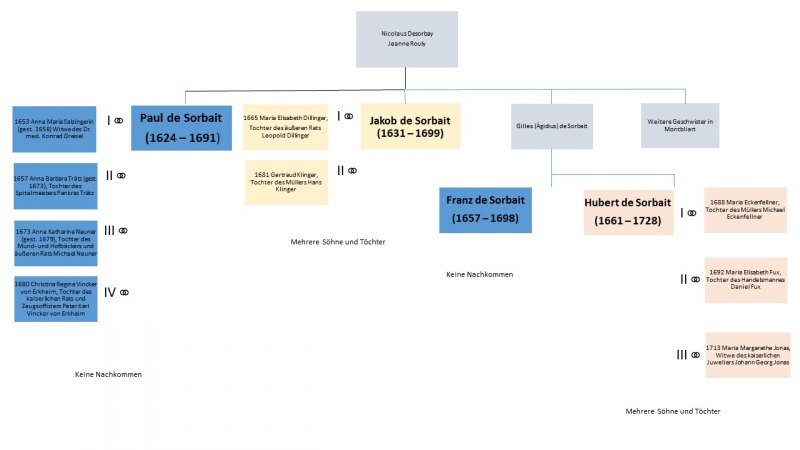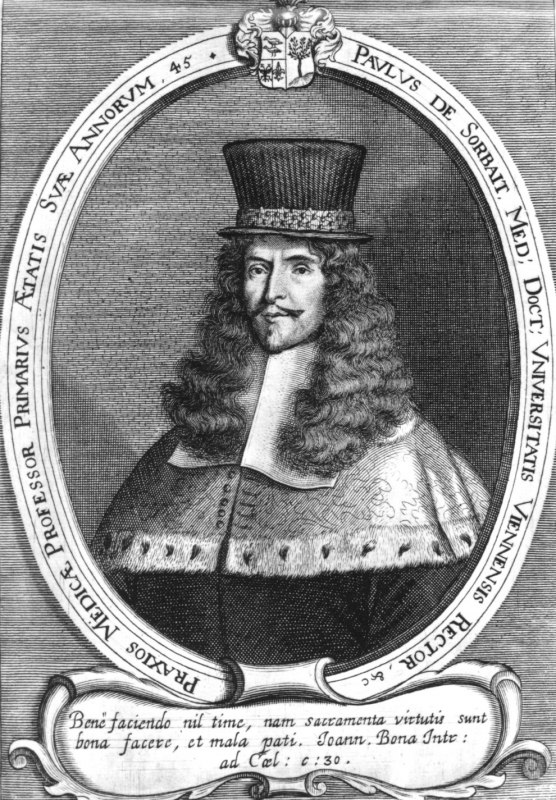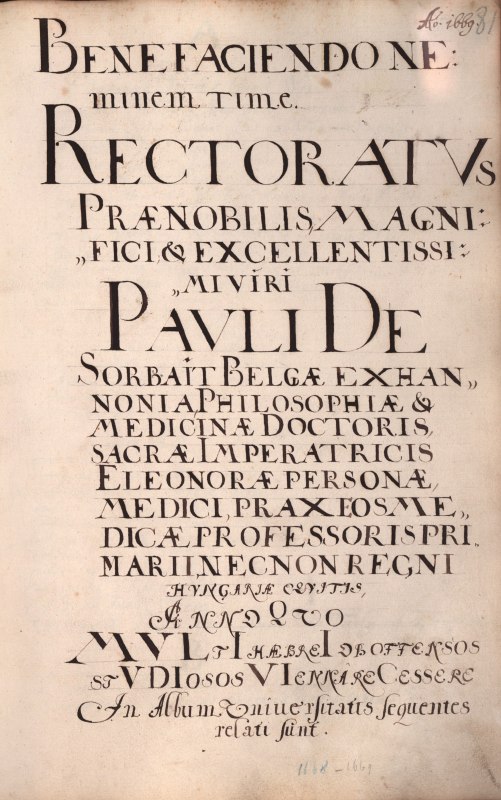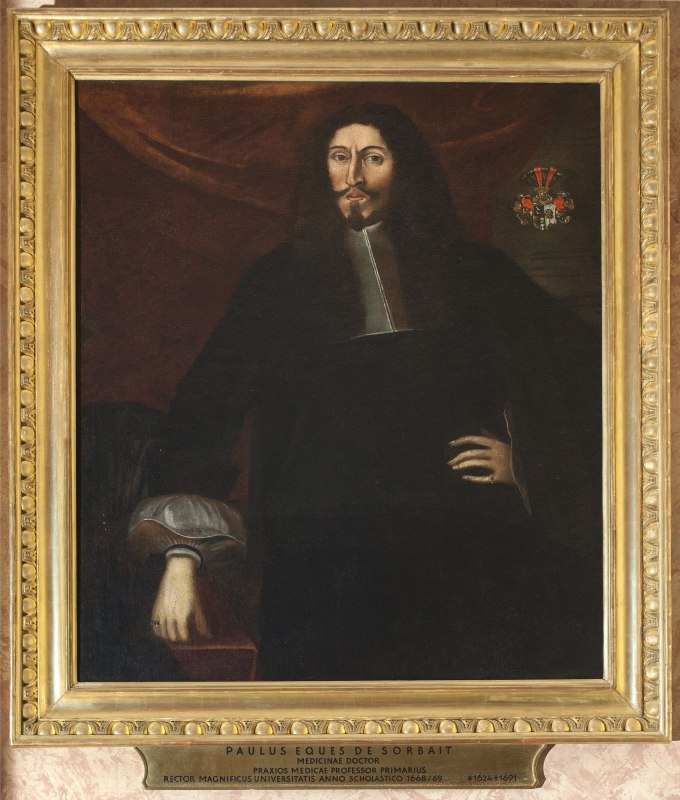Paul de Sorbait, Prof. Dr. med., Dr. phil.
Physician, imperial court physician and personal physician
Ehrungen
| Ehrung | Titel | Datierung | Fakultät | |
|---|---|---|---|---|
| Tor der Erinnerung | Sorbait-Tor | 1998/99 |
|
Funktionen
| Rektor | 1668/69 | |
| Dekan*in | Medizinische Fakultät | 1666/67 |
| Dekan*in | Medizinische Fakultät | 1669/70 |
| Dekan*in | Medizinische Fakultät | 1678/79 |
- Medizin
- Seuchenhygiene
- Medizinische Fakultät
Origin and studies
Paul de Sorbait attended the parish school in his home town of Montbliart and then the Latin school in Thuin, 30 km away. Interested in music, he learned to play the violin at a young age. During the turmoil of the Thirty Years' War, he went to Cologne and experienced the siege of the city of Neuss in 1642.
Sorbait first studied in Paderborn, Vienna and finally in Padua, where he was awarded a doctorate in medicine in 1652. In addition to Greek and Latin, he spoke French, Walloon, Italian and German. After completing his doctorate, Sorbait returned to Vienna, where he settled permanently.
Paul de Sorbait was not the only member of his family to move to Vienna. Presumably with his support, his brother Jakob de Sorbait (1631–1699) was also accepted into the court service as a member of the "Hartschierenleibgarde" (a houshold division at Viennese Court). Two of Sorbait's nephews, Hubert and Franz, also lived in Vienna. Hubert de Sorbait (1661–1728) was a bourgeois wax candle maker, Franz de Sorbait (1657–1698) a barber exempted by the Court.
At the University of Vienna
After arriving in Vienna, Sorbait was admitted to the Faculty of Medicine in 1652. In addition, he was initially a doctor at the Bürgerspital. He was appointed professor of medical theory in 1655 and professor of anatomy and medical practice in 1666. In the academic year 1658/59 he was procurator of the Hungarian nation. He was also elected Dean of the Faculty of Medicine three times (1666, 1669, 1678) and Rector magnificus in 1668. As professor of theory, he was responsible for teaching anatomy and botany. He had the Goldberg Foundation House in Vienna (Johannesgasse 13) renovated for students at his own expense and had a chapel built in it.
Sorbait resigned from his professorship in 1682. During the siege of Vienna by the Ottomans in 1683, he enlisted in the academic legion and was appointed colonel constable. As the siege progressed, he took command of the 3rd Academic Company.
Imperial personal and court physician
From 1657, Sorbait was physician to the court of the widow of Emperor Ferdinand III (1637–1657), Eleonore Magdalena Gonzaga (1628–1686). In the sources he is often referred to as court physician. In this function, he would have been responsible for the court of the Dowager Empress and not for her personally, which is unlikely given Sorbait's reputation. The size of his salary also suggests that he acted as personal physician. He described himself as a "personal and court physician".
His position at court was undoubtedly one of the reasons why Sorbait was accepted into the Academia Naturae Curiosorum, now the German Academy of Sciences Leopoldina, in 1672. The academy named him as a contact person in its application to the Imperial Court Council for imperial recognition in 1676. This was granted in 1677 and is also due to Sorbait's intercession - even though there is no evidence of this.
Plague and health management
In 1678, he recognized the harbingers of the epidemic spread of the plague at an early stage and urged the population and politicians to take measures such as keeping their distance and avoiding mass gatherings of people. Nobody took his advice seriously, and a year later the plague spread rapidly through Vienna and beyond. In 1679, Sorbait was appointed inquisitor general for plague matters and issued a plague regulation based on a manuscript by Johann Wilhelm Ritter von Mannagetta, which was sent to all ecclesiastical and secular authorities, regional courts, burgraves and landed gentry, outlining symptoms, causes, behavioral measures and the establishment of plague hospitals.
Death and afterlife
Paul de Sorbait died of a stroke in his house in Weihenburg on April 29, 1691. He was buried in St. Stephen's Cemetery; today his epitaph can be found in the cathedral in the right aisle (south wall).
The text of the epitaph, which he wrote himself, the will and the funeral sermon present Sorbait as a staunch Catholic: in his will, for example, he denied any possible apostasy in advance. Both the sermon and the epitaph refer to him as a doctor, professor, musician, courtier and soldier, among other things, and emphasize that he had subordinated all aspects of his worldly existence to concern for his eternal life.
Sorbait had already received various honors during his lifetime: in 1682 he was appointed Imperial Councillor and in 1685 he was elevated to the rank of Hungarian knight. In his will, he mentions several valuables that he had received from high-ranking members of the court.
After his death, he was primarily present at the university as the founder of the Sorbait Foundation for two students from his family and from the Netherlands. His name does not appear on the honorary plaques erected by the faculties in 1893.
In contrast, he was prominently depicted on the "Turkish Liberation Monument" erected in St. Stephen's Cathedral in 1894 as the defender of Vienna against the Ottomans in 1683, right next to the city commander Ernst Rüdiger Graf Starhemberg. In contemporary reports on the unveiling of the monument, he is consistently referred to as the university rector at the time, which does not correspond to the historical facts.
In the same year, the City of Vienna decided to rename the outer part of Kandlgasse in the 15th district "Sorbaitgasse". Although the minutes of the meeting do not record any reasons for the choice of name, it can be assumed that the Christian soldier Sorbait was also honored.
The University of Vienna honored one of the "most important personalities in Viennese science" in 1998 by naming one of the "Tore der Erinnerung (Gates of Remembrance)" on the campus of the University of Vienna (Sorbait Gate, passageway from Courtyard 5 to the Institute for Brain Research in courtyard 10).
In collaboration with the Austrian Academy of Sciences, the University of Vienna is dedicating the exhibition "Medikus und Professor, Soldat und Leibarzt. The Viennese plague expert Paul de Sorbait (1624-1691)", which will open on January 25, 2024.
Medical works:
Universa medicina tam theoretica quam practica [Opera medica theoretico-practica]. Norimberga 1672.
Nova et aucta institutionum medicarum Isagoge [...]. Vienna 1678 (revised and improved new edition of Universa medicina).
Consilium medicum dialogus, oder Freundliches Gespräch, uber den betrübten und armselgen Zustandt [...]. Vienna 1679.
Commentaria et controversiae in omnes libros aphorismorum Hippokratis [...]. Vienna 1680.
Praxios medicae, auctae et a plurimis typis mendis [...]. Vienna 1680 (further revision of the Universa medicina; also contains De modo promovendi, some disputations under the chairmanship of Sorbait and the Consilium medicum dialogus).
Pest-Ordnung, oder der gantzen Gemein nutzlicher Bericht und Gutachten von der Pestilentz in genere [...]. Vienna 1680 (revision of Johann Wilhelm Mannagetta's plague regulations).
Works on the history and organization of the University of Vienna:
Modus promovendi doctores in archilycaeo Viennensi […]. Vienna 1667.
Historia rectorum ac illustrium virorum archigymnasii Viennensis. Vienna 1669 (continuation of the Catalogus rectorum by Georg Eder).
Zuletzt aktualisiert am 01.03.2024 - 22:42
-

Family tree of the Viennese family of Paul de Sorbait
The family tree shows the members of Paul de Sorbait ʼs family living in Vienna and their wives, with the names of the brideʼs fathers.
-

Paul de Sorbait (1624–1691), Medicine, Epidemic hygiene
-

Rectorʼs page of Paul (Paulus) de Sorbait (rector 1668/69)
-

Sorbait-Gate of Remembrance on the campus (former General Hospital) between courtyard 5 and courtyard 10, view down from courtyard 5, condition 2019

